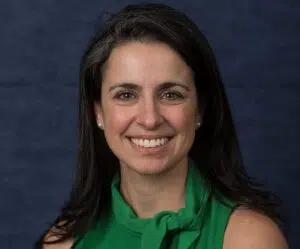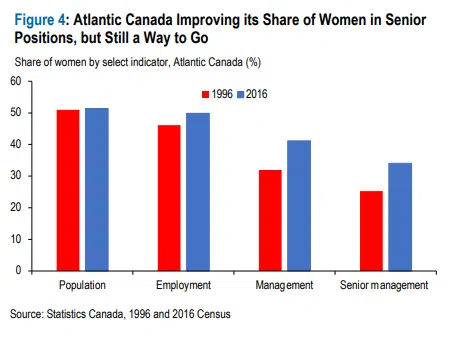
Photo by ThisisEngineering RAEng on Unsplash
As women in Atlantic Canada increasingly ascend into prominent senior management roles, one sector is working hard to encourage gender diversity in its professional workforce even as it grapples with the fact that more needs to happen to make it a reality.
The Association of Professional Engineers and Geoscientists of New Brunswick (APEGNB) is the regulator for the Engineering and Geoscience professions in the province.
Michelle Paul-Elias is the association’s 10th woman president, its 103rd president since 1920, and the third consecutive woman to serve in the position, an example of how things are starting to change.
To APEGNB, diversity means engaging the best minds of the profession, although progress toward gender parity remains slow. Engineering is one of the few licensed professions where men vastly outnumber women.
“Representation matters. If you see it, you can be it,” says Paul-Elias. She recalls attending high school in the early 90s witnessing the big push to get more women into STEM (Science, Technology, Engineering, and Mathematics) fields.

Michelle Paul-Elias, P,Eng. is president of APEGNB. Photo by: Stephen MacGillivray Photography & Video www.stevemacphoto.com
“Certainly, I was interested in those fields, so it probably didn’t take much prodding,” she told Huddle. “The University of New Brunswick would host open houses and they’d bring us on campus into the engineering building and we’d meet professors and I thought, ‘Okay, this is a good fit for me.’”
Paul-Elias says some people are intimidated but in the end it comes down to using problem-solving when doing the degree, with some knowledge of “the basic stuff,” that are STEM components.
Getting into UNB Fredericton’s Engineering studies program thrust Paul-Elias into student networking and, while no one in her immediate family had a professional engineering background, she looked to find her answers by becoming involved at APEGNB.
“I was a field engineer when I started out,” says Paul-Elias. “Sitting on a toolbox driving site-to-site, I worked a lot in the remediation field.”
Her initial experience involved overseeing the safe removal of steel gas tanks at older service stations and the process for changing out tanks in favour of fiberglass replacements.
“For a young engineer getting in, dealing with impacted soils and groundwater, for me it was very hands-on,” said Paul-Elias. She stayed involved in the association through various roles and worked with the Ministry of Environment before joining Irving Oil, where she continues to work today.
“I had great mentors all the way along. I never felt unwelcome,” says Paul-Elias, though she admits there were and still are challenges everywhere for women, something she immediately began to see working on APEGNB’s Council.
An Engineers Canada initiative called “30 by 30” aims to increase women in the profession to 30 percent by the year 2030. Currently, the figure is 18 percent, a number that has held steady over the last several years.
The 30 percent target is held as the tipping point for sustainable change and by reaching its 30 by 30 goal, Engineers Canada hopes to drive cultural change in the profession and be able to support even greater involvement of women throughout.
Recognizing teachers
March is National Engineering Month and the theme for this year is: “There is a place for you.”
APEGNB itself has over 5,900 engineers, geoscientists, engineers-in-training, and geoscientists-in-training registered. In 2021, new registrants who identified as female only totaled 16 percent.
“There’s 16 different engineering disciplines that are being practiced in our province,” says Paul-Elias, “But I do think there’s a place for anyone who wants to do the work.”
APEGNB is working hard to attract more women to engineering. Its diversity and inclusion committee has pushed to offer scholarships to students that identify as female or indigenous.
“The teachers shape everything,” says Paul-Elias. “We’re trying to really give that opportunity for teachers to flex what they can do and expose those young females to engineering and science as early as possible.”
This month, the association is looking to recognize middle and high school teachers who have influenced New Brunswick students in STEM learning through six awards made available each year to educators in Grades 6-12.
“I think there’s a lot of really strong, really bright females that might be very interested in science that perhaps don’t consider engineering,” says Paul-Elias. “But one of the things we want women to realize, and young girls specifically is — there is a place for you here — It’s not an isolating field. You’re mentored all the way through.”
“We know there’s all kinds of proof that the more diverse your working group is, the more successful the better results your business would achieve,” says Paul-Elias. “That would also apply to boards you see, now there is goal setting to have a certain diversity on boards.”
Representation in Atlantic Canada’s labour market
According to the Atlantic Province’s Economic Council, there’s a growing economic imperative to pursue diversity and inclusion beyond the social imperative to ensure economic opportunities and benefits are available for all.
In APEC’s February report: By the Numbers: Diversity & Inclusion in Atlantic Canada, author Fred Bergman looked at the state of diversity in employment in Atlantic Canada.
The report summarizes some of the research on the benefits of diversity, and strategies to pursue it, and Bergman says they’re eager to update it once the segment results from the 2021 Census are released.
One of the key findings from the 2016 Census showed women are well represented in overall employment in Atlantic Canada, accounting for 50 percent of all employees. It also showed Atlantic Canada is outperforming the country in one important metric, with women sitting in more than one-third of all senior managers.
Bergman says while the number on the surface is encouraging In terms of senior management positions, much of it comes from a fairly large public sector in Atlantic Canada, where Bergman notes three out of every five senior managers in health and education are women, while almost one-half of senior managers in government are women.
Over the last two decades, the region’s share of women in management roles has risen 10 percentage points, though women still represent only about 17 percent of board directors in the Atlantic region, compared to 18 percent throughout Canada.

Over two decades, (1996 to 2016), women’s share of Atlantic management roles have risen by 10 percentage points. (Source: APEC, Stats Can)
“Other sectors where you’re seeing a lot of women in senior management positions would be tourism-related industries, like accommodations and food services, hotels, restaurants, professional services,” said Bergman. He added that women are increasingly holding senior titles also as consultants, accountants, and lawyers.
“Having gender-diverse boards is also important for not just women but also people of various racial and ethnic backgrounds, as well as persons living with disabilities and LGBTQ+,” adds Bergman. He says the private sector can learn much from having different perspectives brought about by employing a more diverse workforce overall.
Tyler Mclean is a reporter with Huddle, an Acadia Broadcasting content partner.






